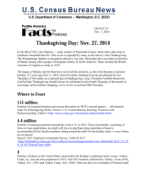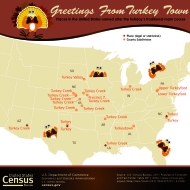Facts for Features: Thanksgiving Day: Nov. 27, 2014
In the fall of 1621, the Pilgrims — early settlers of Plymouth Colony, held a three-day feast to celebrate a bountiful harvest. This event is regarded by many as the nation’s first Thanksgiving. The Wampanoag Indians in attendance played a key role. Historians have recorded ceremonies of thanks among other groups of European settlers in North America. These include the British colonists in Virginia as early as 1619.
The legacy of thanks and the feast have survived the centuries, as the event became a national holiday 151 years ago (Oct. 3, 1863) when President Abraham Lincoln proclaimed the last Thursday of November as a national day of thanksgiving. Later, President Franklin Roosevelt clarified that Thanksgiving should always be celebrated on the fourth Thursday of the month to encourage earlier holiday shopping, never on the occasional fifth Thursday.
Where to Feast
115 million
Number of occupied housing units across the nation in 2014’s second quarter — all potential stops for Thanksgiving dinner. Source: U.S. Census Bureau, Housing Vacancies and Homeownership, Table 8 <//www.census.gov/housing/hvs/data/histtabs.html>
4.4 million
Number of multigenerational households in the U.S. in 2013. These households, consisting of three or more generations, no doubt will have to purchase large quantities of food to accommodate all the family members sitting around the table for the holiday feast ─ even if there are no guests!
Source: 2013 American Community Survey, Table B11017
<//factfinder2.census.gov/faces/tableservices/jsf/pages/productview.xhtml?pid=ACS_13_3YR_B11017&prodType=table>
8
Number of places and townships in the United States that are named Cranberry or some spelling variation of the acidic red berry (e.g., Cranbury, N.J.), a popular side dish at Thanksgiving. Cranberry Township (Butler County), Pa., was the most populous of these places in 2013, with 29,490 residents. Cranberry township (Venango County), Pa., was next (6,583). (Please note that population totals for the two places on the list that are census designated places ─ Cranbury, N.J., with a population of 2,181, and Cranberry Lake, N.Y., with a population of 200 ─ pertain to 2010.)
Source: U.S. Census Bureau, 2013 Population Estimates and 2010 Census Summary File 1 <//www.census.gov/popest/data/cities/totals/2013/index.html> <//factfinder2.census.gov/faces/tableservices/jsf/pages/productview.xhtml?fpt=table>
<//www.census.gov/geo/maps-data/data/gazetteer.html>
42
Number of counties, places and townships in the United States named Plymouth, as in Plymouth Rock, the landing site of the first Pilgrims. The two counties, both named Plymouth, are in Massachusetts (2013 population of 501,915) and Iowa (24,957 in 2013).
Plymouth, Minn., is the most populous place, with 73,987 residents in 2013; There are two places in the United States named Pilgrim: One, a township in Dade County, Mo., had a 2013 population of 128; the other, a census designated place in Michigan, had a 2010 population of 11. And then there is Mayflower, Ark., whose population was 2,299 in 2012, and Mayflower Village, Calif., whose population was 5,515 in 2010.
Note: Townships have been included in these counts from 12 states (Connecticut, Maine, Massachusetts, Michigan, Minnesota, New Hampshire, New Jersey, New York, Pennsylvania, Rhode Island, Vermont and Wisconsin) where the primary governmental or administrative divisions of a county serve as general-purpose local governments that can perform the same governmental functions as incorporated places. These county subdivisons are known as minor civil divisions, and the Census Bureau presents data for these in all data products for which place data are provided.
Source: U.S. Census Bureau, 2010 Census Summary File 1 2013 Population Estimates
Counties: <//www.census.gov/popest/data/counties/asrh/2013/index.html>
Cities and Towns: <//www.census.gov/popest/data/cities/totals/2013/index.html>
2014 U.S. Gazetteer Files
<//www.census.gov/geo/maps-data/data/gazetteer.html>
Participants in the First Feast
24.5 million
Number of U.S. residents of English ancestry as of 2013. Some could very well be descendants of the Plymouth colonists who participated in the autumn feast that is widely believed to be one of the first Thanksgivings ─ especially the 664,000 living in Massachusetts.
Source: 2013 American Community Survey, Table B04006.
<//factfinder2.census.gov/bkmk/table/1.0/en/ACS/13_1YR/B04006>
<//factfinder2.census.gov/bkmk/table/1.0/en/ACS/13_1YR/B04006/0400000US25>
6,500
Number of members of the Wampanoag American Indian tribal grouping, as of 2010, roughly half of whom reside in Massachusetts. The Wampanoag, the American Indians in attendance, played a lead role in this historic encounter, and they had been essential to the survival of the colonists during the newcomers’ first year. The Wampanoag are a people with a sophisticated society who have occupied the region for thousands of years. They have their own government, their own religious and philosophical beliefs, their own knowledge system, and their own culture. They are also a people for whom giving thanks was a part of daily life.
Sources: 2010 Census American Indian and Alaska Native Summary File, Table DP-1
<//factfinder2.census.gov/faces/tableservices/jsf/pages/productview.xhtml?fpt=table>
American Indian Perspectives on Thanksgiving, National Museum of the American Indian <//nmai.si.edu/sites/1/files/pdf/education/thanksgiving_poster.pdf>.
Preparing the Feast … Enjoying the Day … and the Aftermath
98.6%
Percentage of households in 2013 with a gas or electric stove ─ essential for cooking their Thanksgiving feast. Another 96.8 percent had a microwave, also helpful in preparing the meal.
Source: Extended Measures of Well-Being: Living Conditions in the United States: 2013,
Table 3 <www.census.gov/prod/2013pubs/p70-136.pdf>
98.3%
Percentage of households with a television in 2013. No doubt, many guests either before, after, or perhaps even during the feast will settle in front of their TVs to watch some football.
Source: Extended Measures of Well-Being: Living Conditions in the United States: 2013,
Table 3 <www.census.gov/prod/2013pubs/p70-136.pdf>
35.8%
Percentage of households with a stand-alone food freezer in 2013, which they may want to use to preserve their Thanksgiving leftovers. Far more (99.2 percent) have a refrigerator. Once all the guests leave, it will be time to clean up. Fortunately, 69.3 percent have a dishwasher to make the task easier.
Source: Extended Measures of Well-Being: Living Conditions in the United States: 2011,
Table 3 <www.census.gov/prod/2013pubs/p70-136.pdf>
Culinary Delights
66,047
The number of supermarkets and other grocery (except convenience) stores in the United States in 2012. These establishments are expected to be extremely busy around Thanksgiving, as people prepare for their delightful meals.
Source: U.S. Census Bureau, County Business Patterns, NAICS Code 44511
<//www.census.gov/econ/cbp/>
3,240
The number of baked goods stores in the United States in 2012 — a potential place to visit to purchase refreshing desserts.
Source: U.S. Census Bureau, County Business Patterns, NAICS Code 445291
<//www.census.gov/econ/cbp/>
2,788
The number of fruit and vegetable markets in the United States in 2012 — a great place to find holiday side dishes.
Source: U.S. Census Bureau, County Business Patterns, NAICS Code 445230
<//www.census.gov/econ/cbp/>
242 million
The number of turkeys that were forecasted to be raised in the United States in 2014. That is down 5 percent from the number raised during 2012. Source: USDA National Agricultural Statistics Service, <//usda01.library.cornell.edu/usda/current/TurkRaisSu/TurkRaisSu-09-30-2014.pdf>
45 million
The forecast for the number of turkeys Minnesota will raise in 2014. The Gopher State was tops in turkey production, followed by North Carolina (35 million), Arkansas (29 million), Indiana (17 million), Missouri (17 million), and Virginia (16 million).
Source: USDA National Agricultural Statistics Service, <//usda01.library.cornell.edu/usda/current/TurkRaisSu/TurkRaisSu-09-30-2014.pdf>
$19 million
The value of U.S. imports of live turkeys for 2013, with 99.9 percent of them coming from Canada. When it comes to sweet potatoes, the Dominican Republic was the source of 47.8 percent ($5 million) of total imports ($10.4 million). The United States ran a $13.6 million trade deficit in live turkeys during the period but had a surplus of $86.1 million in sweet potatoes.
Source: U.S. Census Bureau, Foreign Trade Statistics
<//www.census.gov/foreign-trade/data/>.
856 million pounds
The forecast for U.S. cranberry production in 2014. Wisconsin was estimated to lead all states in the production of cranberries, with 538 million pounds, followed by Massachusetts (estimated at 210 million). New Jersey, Oregon and Washington were also estimated to have substantial production, ranging from 16 to 55 million pounds.
Source: USDA National Agricultural Statistics Service,
<//usda.mannlib.cornell.edu/usda/current/Cran/Cran-08-14-2014.pdf>
2.4 billion pounds
The total weight of sweet potatoes — another popular Thanksgiving side dish — produced by major sweet potato producing states in 2014
Source: USDA National Agricultural Statistics Service, <//usda.mannlib.cornell.edu/usda/current/CropProd/CropProd-10-10-2014.pdf>
The following is a list of observances typically covered by the Census Bureau’s Facts for Features series:
| Black (African American) History Month (February) Super Bowl Valentine's Day (Feb. 14) Women's History Month (March) Irish-American Heritage Month (March)/ St. Patrick's Day (March 17) Earth Day (April 22) Asian/Pacific American Heritage Month (May) Older Americans Month (May) Mother's Day Hurricane Season Begins (June 1) Father's Day |
The Fourth of July (July 4) Anniversary of Americans With Disabilities Act (July 26) Back to School (August) Labor Day Grandparents Day Hispanic Heritage Month (Sept. 15-Oct. 15) Unmarried and Single Americans Week Halloween (Oct. 31) American Indian/Alaska Native Heritage Month (November) Veterans Day (Nov. 11) Thanksgiving Day The Holiday Season (December) |
Editor’s note: The preceding data were collected from a variety of sources and may be subject to sampling variability and other sources of error. Facts for Features are customarily released about two months before an observance in order to accommodate magazine production timelines. Questions or comments should be directed to the Census Bureau’s Public Information Office: telephone: 301-763-3030; or e-mail: [email protected].





